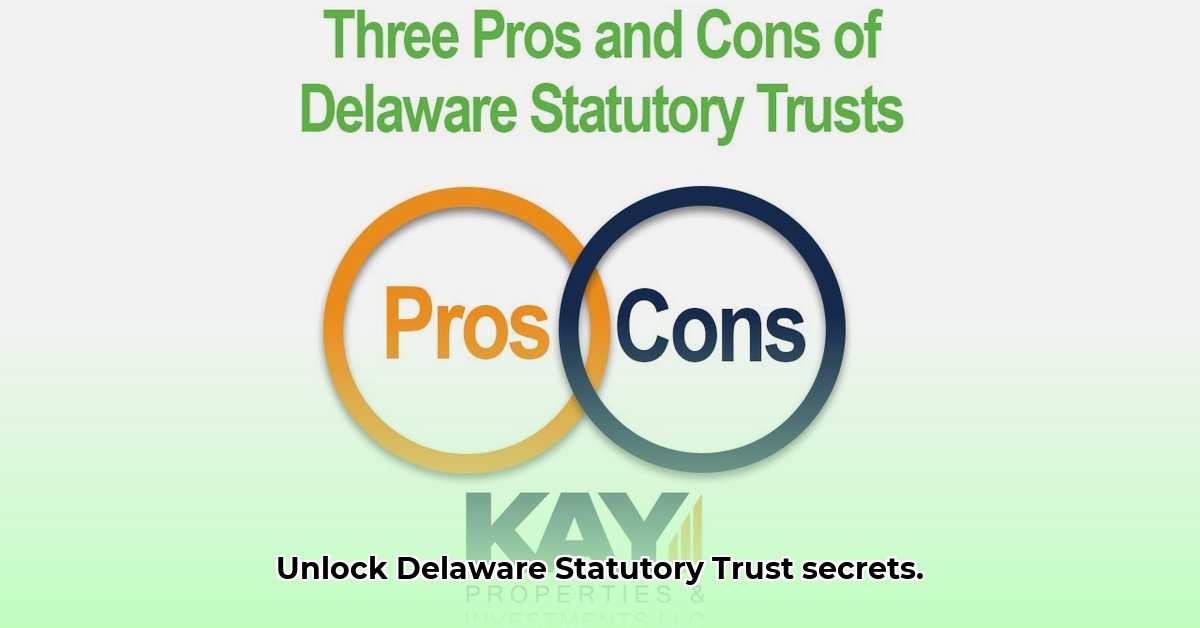
Delaware Statutory Trusts (DSTs) offer a way to invest in large-scale commercial real estate without the complexities of direct ownership. They're particularly attractive for 1031 exchanges, allowing investors to defer capital gains taxes. But are DSTs the right investment for you? This guide explores the advantages and disadvantages to help you decide.
Understanding Delaware Statutory Trusts (DSTs)
A DST pools money from multiple investors to purchase commercial properties, such as large apartment complexes or office buildings. Each investor receives shares representing their proportional ownership. Unlike direct ownership, you don't handle daily management; this is handled by professional managers. This passive investment approach is particularly appealing for those utilizing a 1031 exchange (a tax-deferred exchange of like-kind properties), simplifying the process of reinvesting capital gains tax-free.
Advantages of DSTs: Why Investors are Interested
DSTs offer several key benefits:
1031 Exchange Eligibility: DSTs are structured to comply with IRS regulations for 1031 exchanges, enabling investors to defer capital gains taxes when reinvesting proceeds from a property sale. This significantly improves returns compared to paying immediate taxes.
Professional Management: A team of professionals handles all aspects of property management, from tenant relations to repairs, freeing up the investor's time and expertise.
Diversification: Investing in a DST provides diversification across multiple properties or even different property types within a single trust, potentially reducing overall investment risk.
Access to High-Value Properties: DSTs allow investors to access high-value commercial real estate that might be inaccessible through direct purchase.
Potentially Streamlined Closing: The closing process for DSTs is often faster than directly purchasing commercial real estate. This saves investors valuable time and effort.
Disadvantages of DSTs: A Realistic Assessment
While the benefits are compelling, investors should also consider the potential drawbacks:
Limited Control: As a passive investor, you don't have direct control over property management decisions. You rely entirely on the appointed managers.
Liquidity Concerns: Selling your DST shares before the trust terminates can be difficult, potentially resulting in losses if a quick sale is necessary. There's not a readily available secondary market.
Significant Fees: Numerous fees, including acquisition, management, and distribution fees, can significantly reduce overall returns. Carefully evaluate all fees before investing.
Defined Holding Periods: DSTs typically have a predetermined holding period (often 5-10 years), limiting your access to the invested capital during that time.
Market Risk: Despite professional management, property values are subject to market fluctuations and economic downturns, posing a risk to your investment.
Risk Assessment: A Detailed Look at Potential Pitfalls
Investing in DSTs carries inherent risks. Let's explore these in detail:
| Risk Category | Potential Impact | Mitigation Strategies |
|---|---|---|
| Illiquidity Risk | Difficulty selling shares quickly; potential losses if early sale is needed. | Diversify investments; maintain emergency funds; fully understand the DST's terms and conditions. |
| Fee Risk | High fees substantially reducing returns. | Carefully compare fee structures across various DST offerings; negotiate fees if possible; thoroughly understand all expenses. |
| Management Risk | Poor management impacting property value and returns. | Conduct thorough due diligence on the sponsor’s reputation and track record; assess the management team's expertise. |
| Market Risk | Property value decline due to market fluctuations. | Diversify your investment portfolio; carefully consider current market conditions; monitor the underlying assets' performance. |
| Regulatory Risk | Changes in regulations impacting DSTs. | Stay informed about relevant legislation and consult with legal and financial professionals. |
| Sponsor Risk | Financial difficulties or mismanagement by the DST sponsor. | Thoroughly investigate the sponsor's financial stability and reputation. |
Legal and Regulatory Considerations: Navigating the Legal Landscape
DSTs are subject to federal securities laws and regulations. Understanding these regulations is vital, as they impact investor protections and the overall structure of the investment. Staying abreast of any regulatory changes is crucial for informed decision-making.
Actionable Steps for Investors: A Practical Approach
Investing in a DST demands careful planning and research. Consider these steps:
Comprehensive Due Diligence: Thoroughly examine the Private Placement Memorandum (PPM), paying close attention to the property's condition, sponsor's track record, management team's qualifications, and all fees.
Professional Financial and Legal Advice: Consult with tax and financial advisors to assess the suitability of DSTs for your financial goals and risk tolerance.
Comparative Analysis of DST Offerings: Compare multiple DST offerings, focusing on fees, property types, management teams, holding periods, and other key factors.
Understanding the Long-Term Commitment: Recognize that DSTs involve a long-term commitment. Ensure you are comfortable with the holding period constraints.
Developing a Potential Exit Strategy: While challenging, consider potential exit strategies that might align with your long-term financial goals.
Conclusion: A Balanced Perspective on DSTs
Delaware Statutory Trusts present an opportunity for real estate investment, particularly within the context of a 1031 exchange. However, it is crucial to weigh the advantages—tax benefits, professional management, access to larger properties—against the disadvantages—limited control, illiquidity, and significant fees. Thorough due diligence, informed decision-making, and professional guidance are essential before investing in a DST.